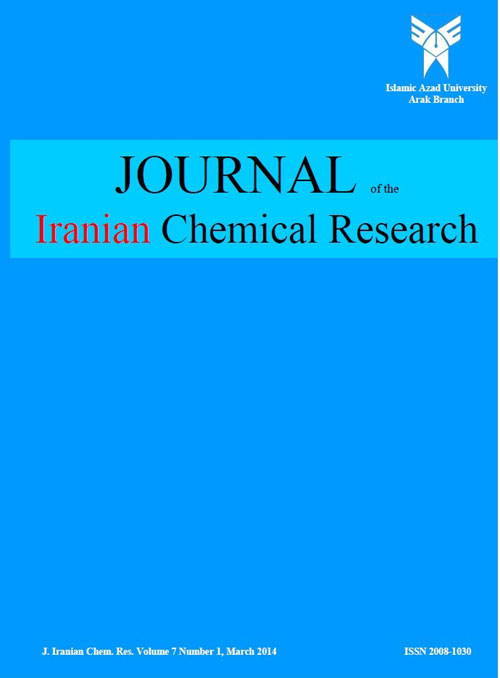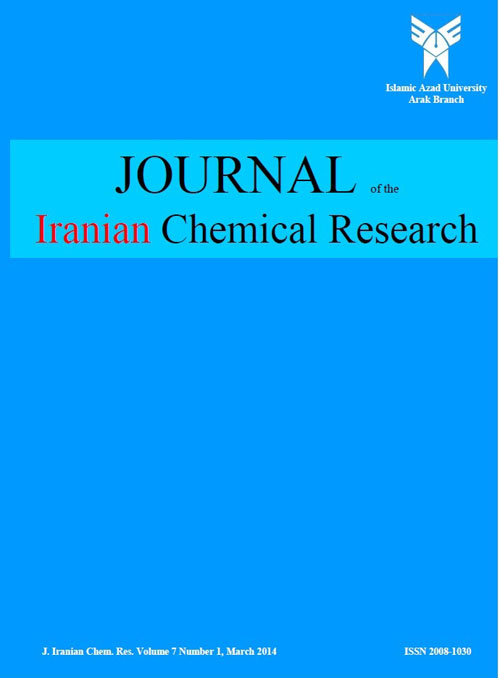فهرست مطالب

Journal of the Iranian Chemical Research
Volume:4 Issue: 2, Spring 2011
- تاریخ انتشار: 1390/03/30
- تعداد عناوین: 8
-
Pages 69-76Two sensitive spectrophotometric methods are presented for the assay of Repaglinide in bulk drug and in formulations using methyl orange, as reagents. Oxidant by reacting with a fixed amount of either methyl orange and measuring the absorbance at 485.2 nm (method-I) and measuring the absorbance at 618.9 nm (method-II). Developed method is based on the formation of extractable colored complex of drug with coloring agent Methyl orange dye. A wavelength maximum was found to be 618.9 nm. The concentration range of 15-50 μg ml-1 with linear regression of 0.9995, while the percentage recovery, LOD and LOQ were 99.42-99.08 %, 2.17 μg ml-1 and 1.08 μg ml-1 respectively. The result of analysis have been validated statistically and also by recovery studies. From the percentage recovery and specificity studies it was concluded that there was no interference of common additives during the estimation. This proves the suitability of this method for the routine quality control analysis of the Repaglinide in
formulation.Keywords: Repaglinide, Derivative spectrophotometry, Area under curve -
Pages 77-85Thermoplastic starch (TPS) materials present several advantages to the plastic industry and when blended with other materials they can exhibit improved mechanical and moisture sensitivity properties compared to pure TPS materials. Further investigations on TPS: PVA blends are of particular interest due to their excellent compatibility and improved properties such as tensile strength, elongation, toughness and processability, predominantly due to an improvement in melt strength compared to pure TPS material. The aims of the study were to investigate the effect of varying polyvinyl alcohol content within the TPS blends on the rate and extent of starch enzymatic hydrolysis using enzyme alpha-amylase. Analyses the enzymatic degradation behavior of poly(vinyl alcohol) with starch was based on the determinations of Weight loss and the reducing sugars. The degraded residues have been examined by FT-IR spectroscopy and scanning electronic microscopy (SEM).Keywords: TPS, PVA, Blend, Enzymatic degradation, ?, amylase
-
Pages 87-91Due to the binding of the COO- group with the mercury (II), gold nanoparticles functionalized with glutathione can self-assemble to form a supermolecular network in the HAc- NaAc buffer solution. The aggregation of functionalized gold nanoparticles and mercury (II) caused the shift of maximum absorption peak of the UV-Vis spectrum from 520 nm to 609 nm. Based on this principle, a simple spectrophotometric method for determination of mercury (II) was preliminarily established. The detection limit of the developed method for determination of mercury (II) was about 8.5×10-8 mol L-1.Keywords: Gold nanoparticles, Mercury (II), Spectrophotometer, Glutathione
-
Pages 93-96Treatment of 1-(5-bromo-2-chloro-6-methylpyrimidin-4-yl)-1-methylhydrazine with dimethylthiocarbamoylchloride gave 7-chloro-N,N, 1,5-tetramethyl-1H-pyrimido[4,5- e][1,3,4]thiadiazin-3-amine in basic acetonitrile. The latter compounds were reacted with secondary amines in boiling ethanol to afford the related 7-amino derivatives.Keywords: 1, (5, bromo, 2, chloro, 6, methylpyrimidin, 4, yl), 1, methylhydrazine, Dimethylthio carbamoylchloride, pyrimidothiadiazine, Cyclocondensation
-
Pages 97-103The classification and regression trees (CART) possess the advantage of being able to handle large data sets and yield readily interpretable models. In spite to these advantages, they are also recognized as highly unstable classifiers with respect to minor perturbations in the training data.
In the other words methods present high variance. Fuzzy logic brings in an improvement in these aspects due to the elasticity of fuzzy sets formalism. ACS, which is a meta-heuristic algorithm and derived from the observation of real ants, was used to optimize fuzzy parameters. The purpose of this study was to explore the use of fuzzy regression tree (RT) for modeling of melting points of a large variety of chemical compounds. To test the ability of the resulted tree, a set of approximately 4173 structures and their melting points were used (3000 compounds as training set and 1173 as validation set). Further, an external test set contains of 277 drugs were used to validate the prediction ability of the tree. Comparison the results obtained from both trees showed that the fuzzy RT performs better than that produced by recursive partitioning procedure.Keywords: Ant colony system, Classification, Regression tree, Melting points -
Pages 105-111A novel optical sensor has been proposed for sensitive determination of bismuth ion based on immobilization of 4-(4-nitrophenylazo)-1-naphthol on a triacetylcellulose membrane. Chemical binding of bismuth ions in solution with a 4-(4-nitrophenylazo)-1-naphthol immobilized on the triacetylcelluse surface could be monitored spectrophotometrically. The optode shows excellent response over wide concentration range 0.4-3.6 μg mL-1 bismuth with a limit of detection of 0.14 μg mL-1 bismuth. The influence of factors responsible for the improved sensitivity of the sensor were studied and identified. The response time of the optode was 30 sec for a stirrer solution. The influence of potential interfering ions on the determination of 0.4 μg mL-1 bismuth was studied. The proposed optode was applied to the determination of bismuth in pharmaceutical formulation samples.Keywords: Optode, Sensor, Bismuth, Determination, Spectrophotometric, Water samples
-
Pages 113-122Amide-iminol tautomerism was studied for ionized oxamic acid (OA) in the gas phase using the DFT method with the UB3LYP functional and various basis sets {6-31(d,p), 6-311(d,p), and augcc- pVDZ}. Among twenty tautomers-rotamers possible for OA, eleven isomers were found to be thermodynamically stable. Similarly as for the neutral molecule, ionization (OA → OA e) favors the amidization process (amide ← iminol). Isomerization seems to change solely the conformational preferences. π-Electron delocalization in the NCO and OCO moieties is close to that for n-π conjugated fragments.Keywords: Oxamic acid, Amide, iminol tautomerism, Ionization, ?, Electron delocalization, DFT
-
Pages 123-126DL-Phenyl alanine labeled with carbon-14 in the α-position has been synthesized from ethyl [2-14C] acetate as part of a 6-step sequence.Keywords: Phenyl alanine, Carbon, 14, Diethyl[2, 14C] malonate, Labeling


